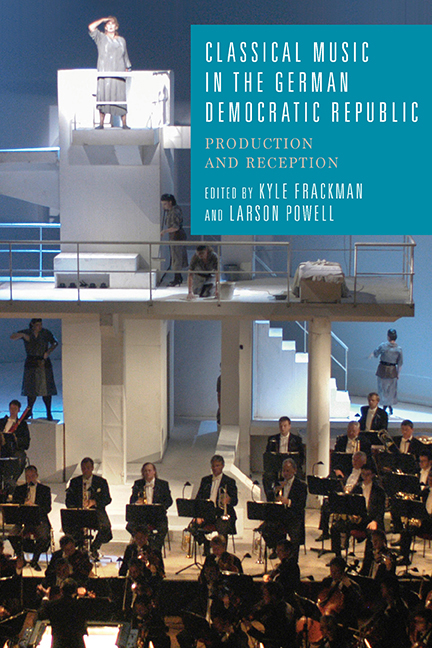Book contents
- Frontmatter
- Contents
- Acknowledgments
- List of Abbreviations
- Introduction: Music and Heritage in the German Democratic Republic
- 1 Provincialism, Modernity, and the Classical Heritage: The Administrative Structure of the GDR and the Situation of Music Production
- 2 Classicism as Anti-Fascist Heritage: Realism and Myth in Ernst Hermann Meyer’s Mansfelder Oratorium (1950)
- 3 Positioning Georg Knepler in the Musicological Discourse of the GDR
- 4 Ehrt euren Deutschen Meister: Reproducing Wagner in the GDR
- 5 The Embodiment of Collective Memory in Neue Odyssee
- 6 Marxism and Feminism in Ruth Berghaus’s Staging of Don Giovanni
- 7 Beyond the Gewandhaus: Mahler and the GDR
- 8 Hanns Eisler’s Funeral and Cultures of Commemoration in the GDR
- 9 Exile—Remigration—Socialist Realism: The Role of Classical Music in the Works of Paul Dessau
- 10 “What a Satisfying Task for a Composer!”: Paul Dessau’s Music for The German Story (. . .Du und mancher Kamerad)
- 11 Friedrich Schenker and the Third Way
- 12 A Prism of East German Music: Lothar Voigtländer
- Notes on the Contributors
- Index
5 - The Embodiment of Collective Memory in Neue Odyssee
Published online by Cambridge University Press: 21 May 2021
- Frontmatter
- Contents
- Acknowledgments
- List of Abbreviations
- Introduction: Music and Heritage in the German Democratic Republic
- 1 Provincialism, Modernity, and the Classical Heritage: The Administrative Structure of the GDR and the Situation of Music Production
- 2 Classicism as Anti-Fascist Heritage: Realism and Myth in Ernst Hermann Meyer’s Mansfelder Oratorium (1950)
- 3 Positioning Georg Knepler in the Musicological Discourse of the GDR
- 4 Ehrt euren Deutschen Meister: Reproducing Wagner in the GDR
- 5 The Embodiment of Collective Memory in Neue Odyssee
- 6 Marxism and Feminism in Ruth Berghaus’s Staging of Don Giovanni
- 7 Beyond the Gewandhaus: Mahler and the GDR
- 8 Hanns Eisler’s Funeral and Cultures of Commemoration in the GDR
- 9 Exile—Remigration—Socialist Realism: The Role of Classical Music in the Works of Paul Dessau
- 10 “What a Satisfying Task for a Composer!”: Paul Dessau’s Music for The German Story (. . .Du und mancher Kamerad)
- 11 Friedrich Schenker and the Third Way
- 12 A Prism of East German Music: Lothar Voigtländer
- Notes on the Contributors
- Index
Summary
EAST GERMAN RUBBLE FILMS and novels of the immediate postwar era frequently adopt “the journey home” archetype to present realistic stories of World War II soldiers and inmates who survive the war and endure arduous travels only to arrive at nonexistent homes. The desolate bombed-out landscapes and physically and emotionally debilitated protagonists central to the establishment of the Deutsche Film-Aktiengesellschaft (DEFA) aesthetic in films like Die Mörder sind unter uns (The Murderers Are among Us, 1946) and Irgendwo in Berlin (Somewhere in Berlin, 1946) were later restaged in East German ballet in Neue Odyssee (New Odyssey, 1957), an adaptation of Homer's Odyssey set in postwar Germany. Neue Odyssee premiered at the Deutsche Staatsoper (East German State Opera) on November 16, 1957 as a full evening-length ballet collaboration between librettist Albert Burkat (1906–75), composer Victor Bruns (1904–96), and choreographer Lilo Gruber (1915–92), and became one of the company's signature works, programmed frequently over the next five years. The ballet was also performed by the Deutsche Staatsoper Ballet on European tours and produced by other ballet companies in the Soviet Union, Poland, and Cuba. This ballet is significant as the first dance work to render a panoramic view of postwar Germany through the eyes of the soldier protagonist, “Der Heimkehrer” (the Repatriate), who wanders through his decimated country in search of his wife and a new place to settle after finding his former home in ruins.
Despite flourishing in courtly centers for centuries, Germany's balletic heritage is overshadowed by its esteemed tradition of classical music. The postwar era brought new enthusiasm for ballet as an art form in both East and West Germany, as state-supported opera houses were financially robust and the ballet companies in residence at opera houses were granted the resources to program independent dance concerts in addition to solely performing ballet sequences in operas. Prior to the construction of the Berlin Wall, West Berlin dance critics received review tickets to performances in East Berlin and regular coverage of ballets premiered by the Deutsche Staatsoper and Komische Oper (Comic Opera) troupes appeared alongside reviews of the Deutsche Oper Berlin company (West Berlin Municipal Opera).
- Type
- Chapter
- Information
- Classical Music in the German Democratic RepublicProduction and Reception, pp. 97 - 118Publisher: Boydell & BrewerPrint publication year: 2015

